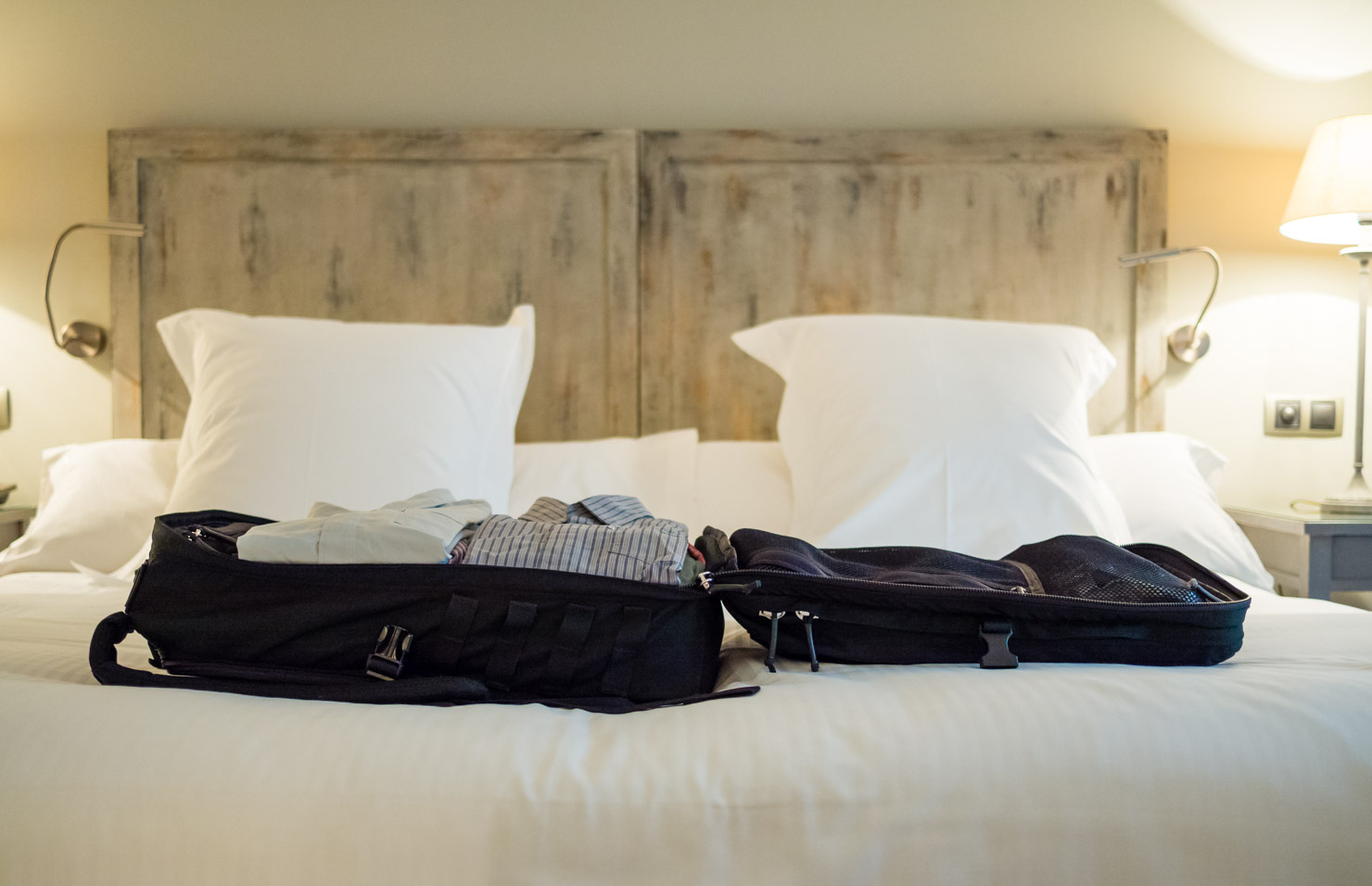Today I read a great article by Ben Brooks, on which type of bag to take for a short trip:
After this recent trip, the answer became pretty clear: backpacks are always the way to go.
Even with the short duration and carry times I did during this trip, a shoulder bag was supremely annoying. It was in my way, noticeable, and uncomfortable even after a short while carrying it. So even though the bag was physically smaller than my GR1, it felt much larger than the GR1. This is a simple matter of how shoulder bags hang and pull at our body.
Agreed. Backpacks are almost always the most comfortable and convenient bags to carry, and they’re always my default choice.
In his piece, Ben also called upon readers to share their own criteria for choosing the right bag for a trip, so here are my two cents on the matter.

General rules
My personal rules for choosing a bag are fairly simple. As a general rule, I will only carry one bag with me, with the possible exception of a small camera bag or a small daypack tucked inside the main bag. For the vast majority of trips though, I’m a one-bag kind of guy.
Also, the bag must be carry-on compatible. I will never check my bag in voluntarily, and the only way I’ll agree to having it checked in is if I’m required to do so by the cabin crew. Unfortunately this can happen sometimes, like when they run out of storage space in the overhead lockers, so always keep a security lock in your bag, just in case.
There are plenty of good reasons never to check in your bag, but that’s a story for another day. For now, suffice it to say that if you can, you should always carry your bag with you on the plane. And don’t make excuses, there’s no real reason to carry more stuff for a trip other than laziness. If I made it for 24 days in Australia and 23 days in Brazil with a single carry-on bag, so can you.
Additionally, there’s one final, very important rule: Under no circumstances will I ever pack more than one week’s worth of clothing and gear.1 For those trips that are longer, I will simply choose to do laundry at my destination once every seven days, however expensive or inconvenient that may be.
In practice though, it’s never really expensive or inconvenient, since many hotels and hostels around the world offer that service or at the very least, facilities you can use. For the few that don’t, you will need to look around town for a self service laundry, or go to a specialized place where you can have it done for you. For example, I paid $25 in Brazil — twice — to have all my clothes cleaned and ironed overnight. That may sound like a lot but I assure you, it was money well spent.
Doing laundry on the go seems like an annoying errand you don’t want to be doing while away on a trip, but the advantages it offers are nothing to sneeze at and the inconveniences are really not that bad. At best, you’ll find plenty of places that will take care of everything for you. At worst, it’ll take a couple hours of your time once a week, it will be expensive, or both. Either way, it definitely beats having to carry a mix of clean and dirty clothes in your backpack for three weeks in tropical weather. Trust me.
Bag choices and recommendations
Once the general rules are set and when it comes to which bag to carry, it all hinges on the duration of the trip and the expected weather conditions. These are my bags of choice for each situation:
Two or fewer days in warm weather: The GORUCK GR Echo. If you can pack light, this bag is just the right size for short escapades. I use it all the time when I go to my hometown to visit my folks for the weekend, and I love it. I typically carry a couple spare shirts, underwear, my laptop with charger, a dopp kit and maybe my Kindle for these trips. Anything else and you’re not really packing light anymore.
Three to five days in warm weather, or up to four days in colder conditions: a 25-liter backpack. I personally use an all-black Nike Hayward 25M backpack, which I’ve owned for over a decade. I wasn’t expecting much of it in terms of performance, particularly given its rather modest price tag — I seem to remember paying something like $70 for it when I bought it all those years ago. Surprisingly though, this bag far and away exceeded all my expectations. Sadly, this particular model was discontinued by Nike and the current one is a lot less to my liking, so when the time finally comes to upgrade my bag I will probably buy a GORUCK GR1 instead.
Six or more days in good weather, five or more days in colder conditions: The GORUCK GR2. I wouldn’t pick any other bag over the GR2 for a serious trip, with just one caveat: big backpacks are heavy, and the GR2 is no exception. If you foresee the need to walk a lot, you may want to opt for a different type of bag, like a rolling suitcase, for example. Yes, they’re less convenient and maybe even less fancy, but your back will thank you for it. And another thing: carrying a backpack makes your back sweat. A lot. There’s simply no way around it, so be prepared and keep a spare shirt handy in case you need to change during your trip, or upon reaching your destination. Hugging your welcoming hosts with a sweaty back is just bad etiquette.
Cycling trips: The Ortlieb Back Roller City panniers. Depending on the duration of the trip, I will take one or both panniers with me. These are incredibly durable and completely waterproof, so there’s no need to worry when you’re pedaling your way across a river — although, if you do find yourself in that situation, you may want to stop and think hard about your travel choices. Just saying.
That pretty much covers every type of trip I usually take. These rules are very easy to follow and remove any uncertainty about what to pack and how to pack it. They have served me well in the past but of course, your mileage may vary.
In any case, these are flexible rules and nothing is set in stone. For example, if a short trip requires more formal clothing I will probably choose to go with a bigger bag. The key is to play with them a little bit, make them work for you and your particular trip, and find the right balance.

Finally and above all, remember that with packing, as with many things in life, practice makes perfect. So if you really want to get better at it, you’re just going to have to keep traveling.
-
As a side benefit, this also helps with the no checked baggage rule above.↩